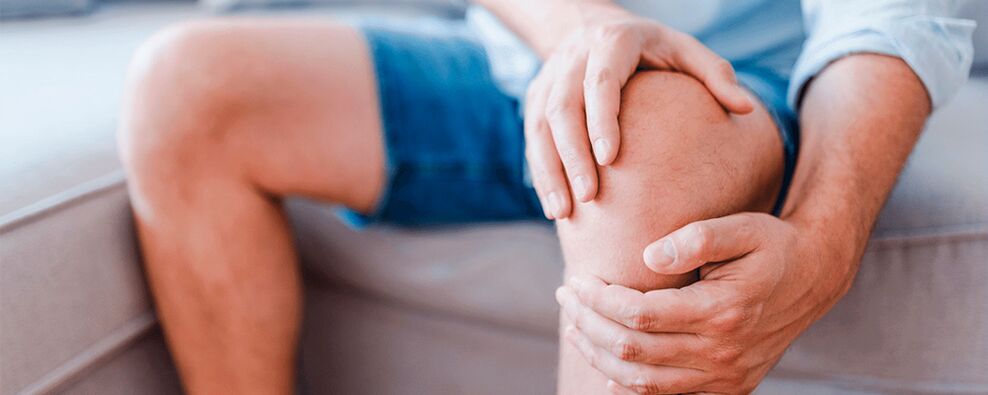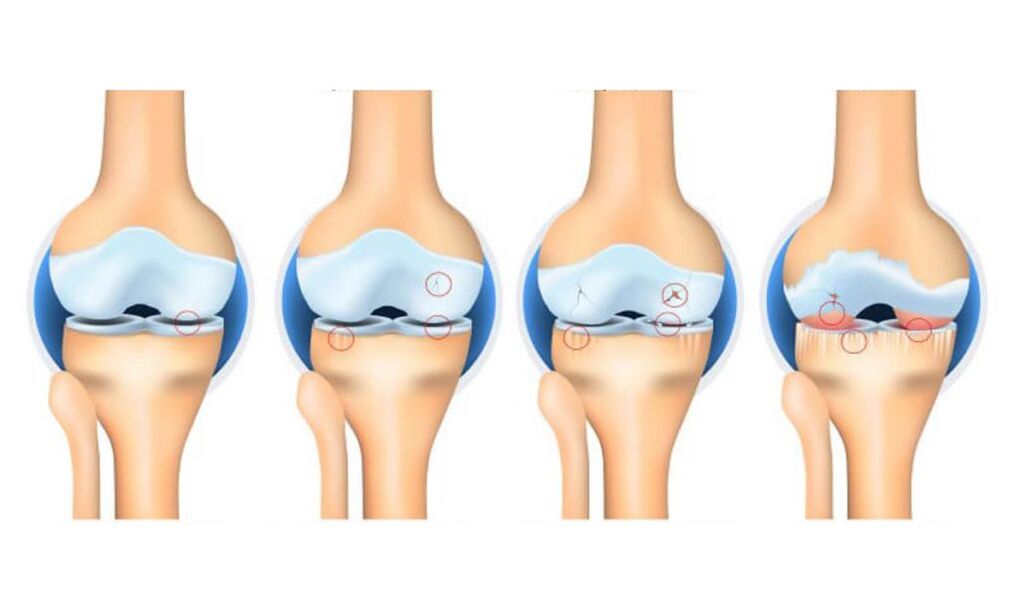
The following factors may contribute to the development of knee arthrosis:
- excessive physical activity that does not meet age requirements, leading to joint damage;
- sedentary lifestyle;
- suffered injuries to the knee joints - knee dislocation, fractures, ligament tears and ruptures, damage to the meniscus body, severe knee falls, bruises;
- increased body mass index, which causes increased strain on the joints, meniscus rupture;
- heredity;
- arthritis or other joint diseases (inflammation can lead to edema or the accumulation of large amounts of joint fluid in the joints, provoking the destruction of cartilage tissue);
- metabolic disorders that lead to the excretion of calcium from the body;
- diabetes mellitus of any type, hormonal disorders and other pathologies of the endocrine system;
- chronic or previous inflammatory and infectious diseases;
- violation of blood flow;
- lupus erythematosus, rheumatoid, gouty and psoriatic pathologies, ankylosing spondylitis;
- flat legs, which causes the center of gravity to shift and the load on the joint to increase;
- nervous overload and stressful situations.
Why arthrosis of the knee joint occurs
Most often, people themselves become guilty of developing such an incurable disease. Often, when knee pain appears, people ignore the painful feelings, preferring to go to the doctor to use medications that simply mask the pain.
After a few years, you will still need to see a specialist, as self-healing will not work with such a diagnosis. However, the severity of arthrosis will be at least moderate. Here, it is no longer enough to use ointments, hyaluronic acid within the joint, and preventive physical education, which could be done in the early stages of the disease. Radical action is likely to be required, including sometimes surgery.
Symptoms and diagnosis of arthrosis of the knee joints
The disease can be distinguished on the basis of the following characteristics:
- Pain syndrome. Painful feelings usually occur suddenly, but most often with physical exertion, even mild. The pain can be of a different nature. At first, these will be weak lumbagos (unfortunately few pay attention to them). Mild pain that occurs only intermittently can take months or even years until the disease progresses to a more severe stage.
- Significant knee deformity. A similar symptom is characteristic of later stages. And at the onset of arthrosis, the knee swells and swells slightly.
- Appearance of dense formations in the posterior wall of the knee joints. Accumulation of large amounts of joint fluid in the cavity of the Baker's cyst or in the joint itself.
- Sharp rupture of the joints accompanied by pain.
- Decreased joint mobility. This is especially pronounced in the last stages of arthrosis. In this case, bending and stretching the knee causes severe pain, and in the final stages, movement becomes almost impossible.
REFERENCE! In a patient with arthrosis, the gait changes: it is characterized by sagging and limping of the legs.
Pathogenesis of knee arthrosis
Specialists distinguish between primary and secondary arthrosis.
Primary arthrosis of the knee joints
The following processes are characteristic of primary gonarthrosis:
- The articular cartilage is constantly destroyed, but at the same time it can regenerate quickly. Under normal circumstances, these two processes must balance each other. As you age, cartilage decays at the same rate, but its recovery slows down. The mass of man plays an important role here. Indeed, if a person weighs 70 kg, a foot weighs 700 kg in 10 steps and a 120 kg can weigh up to 1200 kg, which puts a significant strain on the joints and joints. cartilage, which therefore wears out faster.
- It is important to note that the joint is only fed with useful elements during movement. A sedentary lifestyle leads to a slowdown in metabolic processes, which means that the necessary nutrients do not reach their destination.
- The likelihood of developing gonarthrosis increases in people whose parents have suffered from the disease.
Secondary arthrosis of the knee joint
It develops for the following reasons:
- Multiple injuries. They cause excessive stress on the cartilage in a person of any age. If any cartilage-covered bone breaks, irregularities called "steps" appear. In this area, the joint now wears out with every movement, leading to arthrosis.
- Development of rheumatoid arthritis, Koenig's disease, purulent inflammation in the joint area.
- Vascular dysfunction.
Classification and developmental stages of knee arthrosis
The orthopedist divides gonarthrosis into stages on which further treatment of the disease depends. Of course, the course of treatment also depends on other factors, such as the causes, location, and nature of the development of arthrosis.
IMPORTANT! Quality treatment should only be prescribed by a doctor after a full study of the disease picture. Self-medication can only worsen your health.
The main classification divides gonarthrosis into four stages of development:
- Initial phase. At this stage, the disease is just emerging. External symptoms are barely noticeable or completely absent, the shape of the joint is in a satisfactory condition. Symptoms include only mild discomfort or heaviness in the knee after long walks, as well as heavy physical exertion. X-ray examination provides little information: the x-ray shows only a slight narrowing of the joint gap. Unfortunately, at this stage, one does not seek medical attention due to the insignificance of the symptoms.
- The second stage is characterized by a noticeable pain syndrome, especially when walking and climbing stairs, as well as at night. The severity of the pain decreases at rest. The joints become difficult to move. You will hear kneeling or squeaking while walking. X-rays show a narrowing of the joint gap as well as osteophytes. The patient begins to limp.
- When arthrosis progresses to the third stage, the pain syndrome is felt continuously, even in the absence of movement. The deformation and degeneration processes go into an irreversible phase. Joint distortion becomes pronounced, the distance between joint surfaces decreases noticeably, and the size of many osteophytes increases. The painful feelings now disturb the patient even in complete calm. A person becomes addicted to outside support (walkers, sticks) and needs the help of others. Conservative treatment is less effective at this stage.
- The fourth stage is characterized by constant debilitating pain. The number and size of osteophytic growths increase, cartilage is completely destroyed, the joint gap is barely traceable or completely absent, and the bones are severely deformed. Even weak movements become torture for the patient. At this stage of gonarthrosis, the patient is recognized as disabled. In the absence of surgery, the disease can lead to disability.

Complications of arthrosis of the knee joints
Advanced arthrosis can lead to dislocation and subluxation of the knee joint. In the case of dislocation, the femoral epiphysis extends completely outside the joint, making movement in the joint impossible and the axis of the foot shifted substantially to the side. Fortunately, such negative variants of the disease are quite rare.
Subluxes are more common. They are characterized by a partial displacement of the joints relative to each other and a slight deviation in the axis of the tibia. In this case, subluxations are accompanied by severe pain and joint dysfunction.
Ignoring the disease can lead to complete loss of lower limb function.
ATTENTION! The habit of sparing a sore foot sometimes causes deformity of the intervertebral discs and the appearance of hernias.
Consequences of neglected gonarthrosis
The advanced stage of gonarthrosis is almost always characterized by the following adverse symptoms:
- day and night pain from which no painkiller can save;
- loss of limb support (impossible to stand on or at least lean on a sore leg);
- immobilization of the joint block;
- pronounced curvature of the bones around the knee;
- severe swelling around the affected area.
Methods for treating knee arthrosis
The treatment prescribed depends on the degree of development of the disease. There are several therapeutic options.
Hormones
These medications are prescribed for severe exacerbation accompanied by synovitis and severe pain. The hormones are usually given by injection. The following drugs are most commonly used:
- Flosterone;
- Diprosphan;
- Hydrocortisone.
The duration of hormone treatment is usually short, and injections are given only during severe exacerbations. The hormones are given on average once every 10 days.
Chondroprotectors
Chondroprotectors are prescribed in the early stages of the disease. This therapy is currently the most effective and safest: there are virtually no contraindications and side effects are the rarest.
The drugs are designed to restore cartilage tissue, improve metabolic processes, nourish cartilage tissue, and protect against further destruction. But in the last stages of arthrosis, chondroprotectors are also helpless.
This class of drugs is produced in the form of injections, ointments, gels, tablets.
Vasodilators
These funds are needed to eliminate small blood vessel spasms, increase blood circulation, and supply nutrients to the affected joint area. Vasodilators were prescribed in combination with chondroprotectors.
If joint fluid does not accumulate during gonarthrosis (no arthritis), the use of warming ointments is recommended.
Hyaluronic acid
Otherwise, this device is called an intraarticular fluid prosthesis because the composition of the acid is similar to an intraarticular fluid. By injecting the acid into the joint, it forms a film that prevents strong friction of the cartilage during movement, affects the extracellular matrix, improves joint metabolic processes, and initiates the production of its own hyaluronic acid in the joint - e. g. normalizes the function of the joint, stops the pathological processes that destroy cartilage. . . .
Acid treatment is prescribed only if the exacerbation synovitis has resolved.
Physiotherapy
Physiotherapy exercises will only yield positive results if prescribed by a physician after a complete study of the medical history and all exercises are performed under the supervision of a specialist.
Self-medication often leads to worsening of the joint condition. Training therapy is prescribed for the following purposes:
- slowing the development of stiffness;
- preventing further destruction of cartilage tissue;
- elimination of muscle cramps leading to pain.
Physiotherapy
Various procedures can be prescribed as complementary therapy: electrophoresis, acupuncture, laser therapy, UHF, and diadynamic currents. The local massage also gives good results.
The goal of physiotherapy is to reduce the severity of pain, eliminate inflammation, normalize the metabolic processes within the affected joint, and restore normal function.
IMPORTANT! It is important for the patient to monitor their diet and avoid strenuous physical exertion.
Forecast. Prophylaxis
Due to the advanced stage of the disease, the predictions are disappointing. Therefore, it is recommended that you seek medical advice if you experience minor symptoms of arthrosis.
Vulnerable persons (elderly, athletes, overweight) must follow the doctor's recommendations and follow the following rules:
- Eat right and keep your weight under control. Follow a weight loss diet as needed.
- When exercising, reduce the strain on your joints and keep an eye out.
- Timely treatment of infectious diseases, preventing their transition to the chronic stage.
- Relax properly, avoid stressful situations if possible.
- Increase the body's protective functions (occasionally take vitamins, temper).
- Avoid hypothermia of the body, especially the lower extremities.


















































